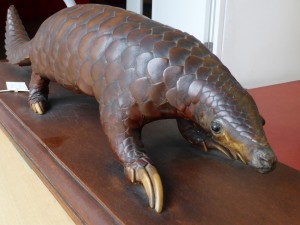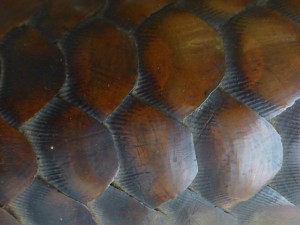Revisiting Singapore with Annie ‘In Conversation’ and I am finally able to spend time with the pangolin, normally squirrelled away in the Victorian study. He/she has captured something quite distinctive of mine and Annie’s journeys, and has provided fascination and wonder since first sight. Annie was given a pangolin as a present by the ex-Sultan of Johore at which she was rather perplexed:
…”a live little beast, not an alligator, and not an armadillo or a lizard; in fact I do not know what it is; it clings round my arm just like a bracelet…” (A Voyage in the Sunbeam, A. Brassey 1878)
One hundred and thirty seven years on and it is still a creature that captures the imagination. They are not easy to find now and there are not many left. All eight species of pangolin are threatened with extinction and are listed under Appendix II of CITES (the Convention on International Trade in Endangered Species of wild fauna and flora). This means any trade is regulated and monitored. There is a zero export quota for all four Asian species of pangolin. Despite this, pangolins are the most illegally traded mammal in the world (Save Pangolin Association, 2015). Reported as the creature that may become extinct before it is even recognised by many it has been subject of a high profile in the media recently. It is a creature that conjures images of fairytales and fantasy.

Pangolin, Bexhill Museum (Louise Kenward, 2015)
The pangolin is sometimes described as a scaly anteater, a mammal with a tongue longer than its body, they live in trees and burrow in the ground. Solitary, nocturnal animals, they foster a description of being ‘secretive’. With a hard protective shell of scales they roll into a ball to defend themselves and are notoriously difficult to keep in captivity. This makes Annie’s pangolin all the more surprising. When rescued from illegal trade they are difficult to look after and rehabilitate. This focusses conservation efforts on prevention; training rangers and developing education programmes. For more information and links to ways you can help see www.savepangolins.org.

Pangolin (detail), Bexhill Museum (Louise Kenward, 2015)

Annie with pangolin, Bexhill Museum (Louise Kenward, 2015)
I don’t remember seeing any wildlife during my visit, although spent little time in Singapore, my postcard to Annie was hurriedly sent from the airport as I waited for my flight to Jakarta. Just a day or so to explore the stunning architecture of this incredible modern city. The performing arts building on the Esplanade is inspired by the durian fruit, a bridge in the centre of the city is inspired by the structure of DNA. The skyline and the streets are clean. Chewing gum is banned. Slick shopping centres are vast and expensive. The seafood is very good.
Comparing my experiences to Annie’s, things have changed quite considerably:
“the town… [was] not imposing, its streets, or rather roads of wooden huts and stone houses, being mixed together indiscriminately…As soon as the Governor and his suite had set off for Johore we went down into the hot dusty town to get our letters, parcels, and papers, and to look at the shops. There are not many Malay specialities to be bought here; most of the curiosities come from India, China, and Japan, with the exception of birds of Paradise from New Guinea, and beautiful bright birds of all colours and sizes from the various islands in the Malay Archipelago.”
I don’t recall any dust in Singapore but did find the post office Annie visited. Now converted to a hotel.
Work at the museum is progressing. I am writing and drawing, photographing and talking. Displays are being altered and updated, shifted and edited.
